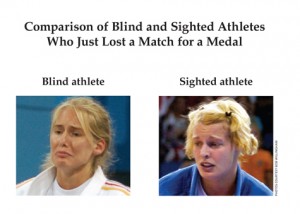A 2008 study conducted by Humintell Director Dr. David Matsumoto and Photographer Bob Willingham investigated whether or not facial expressions of emotion were innate or a product of cultural learning.
The study, which was the first of its kind, studied congenitally blind (blind from birth) and sighted judo athletes at the 2004 Paralympic Games and the 2004 Summer Olympic Games in Athens, Greece.
Their journal article entitled “Spontaneous Facial Expressions of Emotion of Congenitally and Noncongenitally Blind Individuals” was published in the Journal of Personality and Social Psychology in 2009.
During the course of the study, more than 4,800 photographs were captured and analyzed, including images of athletes from 23 countries. According to the findings, there were “no differences between congenitally blind, noncongenitally blind, and sighted athletes, either on the level of individual facial actions or in facial emotion configurations”. This meant that the blind and sighted athletes produced the exact same facial expression, firing the exact same muscles at exactly the same time in similar situations.
For example, below are images of women who had just lost a medal match. The woman on the left is the non-sighted athlete and the woman on the right is the sighted athlete. As you can see, the expressions are both of sadness. The brows are drawn up and together in both pictures, indicating sadness.

These findings “provide compelling evidence that the production of spontaneous facial expressions of emotion is not dependent on observational learning but simultaneously demonstrates a learned component to the social management of expressions, even among blind individuals”.
In essence, facial expressions of emotion are hardwired into our genes and are not learned culturally.
“Losers pushed their lower lip up as if to control the emotion on their face and many produced social smiles,” Matsumoto said. “Individuals blind from birth could not have learned to control their emotions in this way through visual learning so there must be another mechanism. It could be that our emotions, and the systems to regulate them, are vestiges of our evolutionary ancestry. It’s possible that in response to negative emotions, humans have developed a system that closes the mouth so that they are prevented from yelling, biting or throwing insults”.
References:
San Francisco State University (2008, December 30). Facial Expressions Of Emotion Are Innate, Not Learned. ScienceDaily. Retrieved August 17, 2010, from http://www.sciencedaily.com /releases/2008/12/081229080859.htm
 Like many aspects of human behavior, laughter is complicated.
Like many aspects of human behavior, laughter is complicated. NPR recently featured an amazing and fascinating story about Jonathan Keleher, a 33 year old man who was born with part of his brain missing. Keleher is one of a handful of people known to have lived their entire lives without a cerebellum, a structure that usually contains about half the brain’s neurons.
NPR recently featured an amazing and fascinating story about Jonathan Keleher, a 33 year old man who was born with part of his brain missing. Keleher is one of a handful of people known to have lived their entire lives without a cerebellum, a structure that usually contains about half the brain’s neurons.